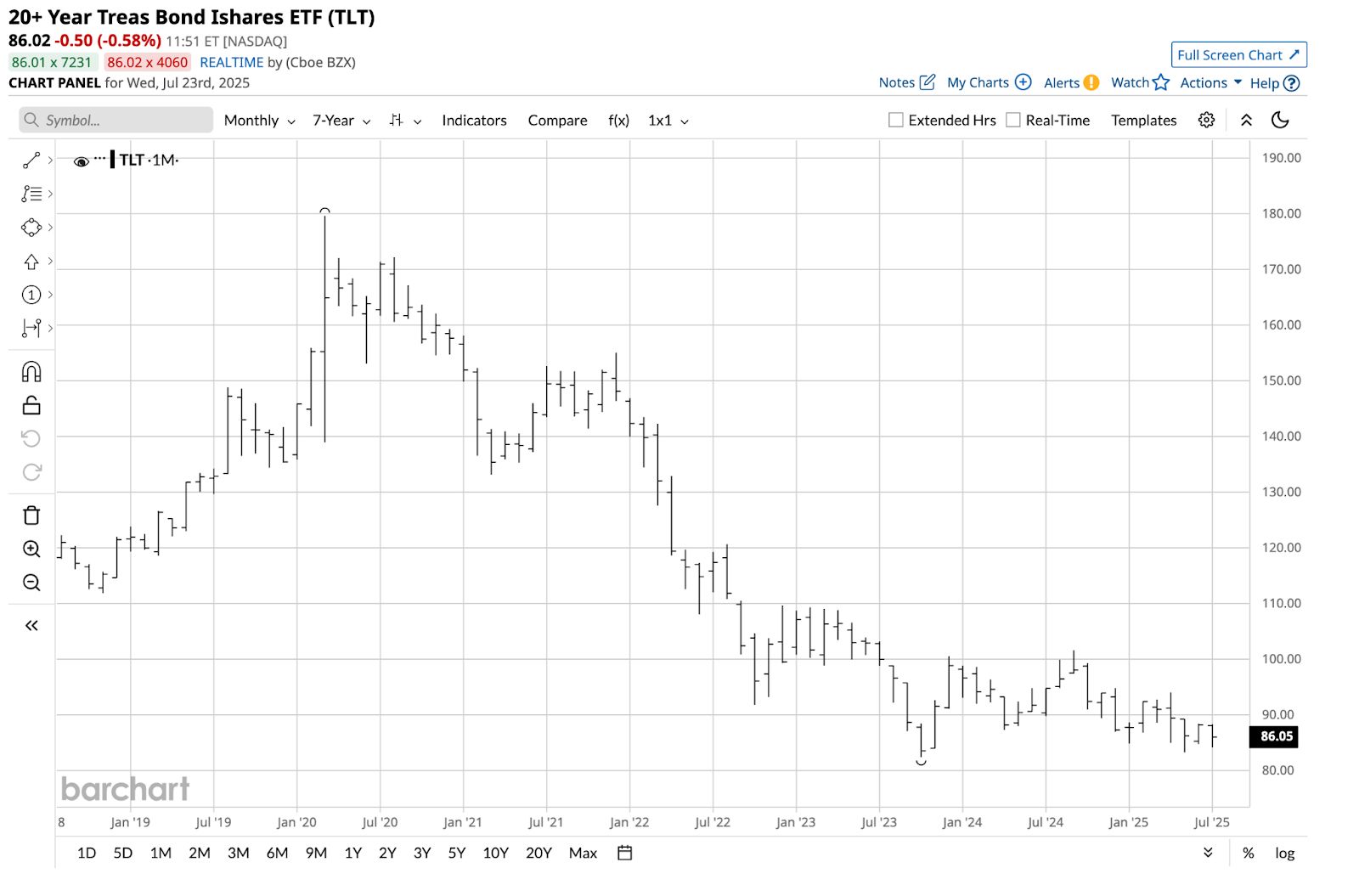- Smart Options Trader
- Posts
- Japan Agreement Triggers Massive Options Unwind
Japan Agreement Triggers Massive Options Unwind
Trade uncertainty dissolves as negotiation template emerges, potentially accelerating timeline for interest rate relief.

Sector rotation accelerates from defense to offense while Treasury bonds position for Fed policy pivot.
🕒 Market Overview: VIX drops full percentage point as trade uncertainty evaporates
🔄 Sector Insight: Auto and tech options explode while defensive positioning unwinds rapidly
💰 Today's Trade Idea: Bull Call Spread on TLT targeting Fed rate cuts
MARKET BREAKDOWN
Macro Lens – Big Picture Market Forces
Markets experienced a wholesale sentiment reversal following the US-Japan trade agreement, which slashed expected tariffs from twenty-five percent to fifteen percent. The psychological impact extends far beyond the bilateral arrangement, establishing a negotiation template that traders are applying to upcoming August deadlines.
The Federal Reserve's policy path faces a fundamental shift as inflationary tariff concerns diminish. With additional trade deals potentially reducing worst-case tariff scenarios, the central bank gains flexibility to address the current rate environment. Chairman Powell's term ending in early 2026 adds political pressure for accommodation.
Volatility indicators confirm the magnitude of this sentiment shift. Equity put-call ratios collapsed from defensive territory to neutral levels within hours, while index options showed the most dramatic reversal from pessimistic to balanced positioning.
Sector and Stock Watch – Identifying Key Movers
Automotive sectors led the charge as Japanese manufacturers saw options volume surge well above normal levels. Toyota, Honda, and Nissan experienced volatility crush as expensive puts became worthless insurance against avoided outcomes.
European automakers captured secondary benefits through reduced Japanese competitive pressure. Volkswagen, BMW, and Mercedes-Benz attracted significant call activity as traders positioned for market share gains.
Currency markets reflected improved Japanese economic prospects, with yen strength against the dollar accompanied by continued positioning for further appreciation based on Bank of Japan policy flexibility.
Trading Strategy in Focus – How to Play the Market
The sector rotation from defensive to offensive positioning creates opportunities across multiple asset classes. Utilities and consumer staples saw hedging demand evaporate, while industrials and materials experienced call option interest surges.
Treasury bonds present the most compelling setup as trade uncertainty reduction opens the door for Fed accommodation. Lower short-term rates appear increasingly likely as the administration's negotiation strategy produces results, reducing inflationary pressures from tariff implementation.
Technical resistance levels on TLT at April 2025 highs near $94 and September 2024 highs near $101 provide clear upside targets for positioning ahead of potential Fed policy shifts.
SMART TRADE IDEA
Bull Call Spread on TLT
Trade Setup: Buy $87 Call / Sell $95 Call, January 16, 2026 expiration
Cost: Cost: $2.17 ($217 per spread)
Max Profit: $5.83 ($583 per spread)
Breakevens: $89.17 on TLT
Risk-reward: 1:2.69
Management Plan: Exit at 50% loss, roll up, or take profits if TLT's price reaches $94.
The upside target is just below the first technical resistance level on the TLT ETF. If all tariff fears subside and interest rates begin to decline, the TLT's potential upside could be far greater than the initial upside technical target, making rolling the call spread up to higher strike prices an optimal approach. The January 2026 expiration provides plenty of time for new trade deals to emerge and interest rate markets to react.
NOTE: Remember, options trading involves substantial risk and is not suitable for all investors. Consider your investment objectives, financial resources, and experience level before implementing this or any options strategy.
DISCLOSURE: Trade recommendations may have changed since publication. Evaluate current market prices and risk/reward before acting. Trading involves significant risk and is not suitable for everyone. This is not personalized investment advice. Past performance doesn't guarantee future results. Publisher and contributors may hold positions in recommended securities. Readers assume full responsibility for their trading decisions. Consult a financial professional before investing.
 | Andy Hecht | Second TakeWall Street veteran and analyst covering technical and fundamental factors in markets across all asset classes for over four decades. |
Never underestimate the Trump administration's use of drama to achieve its goals. The April 2 Liberation Day announcement sent markets reeling. Still, the ultimate goal was not to impose unprecedented trade barriers, but to move the needle on trade and achieve a victory in moving trade toward a more level playing field. The negotiating style involves pushing the envelope to the maximum, and then identifying areas of cooperation where deals are possible. The agreement with Japan is an example of the administration's goals and strategy, as well as a route to moving the trade needle. Aside from the occasional bluster, many more trade deals and agreements that move the needle toward leveling the playing field between the U.S. and its trading partners are likely on the horizon.
Meanwhile, concerns about the inflationary impact of tariffs are likely to subside over the coming weeks and months as the administration announces new agreements and deals. Therefore, U.S. interest rates are likely to decline, taking pressure off of funding the debt and igniting economic growth. Given the deal with Japan and the potential for other trade agreements, the Fed may begin reducing rates, with inflationary pressures remaining below the 3% level. While the Fed's target remains at 2%, the current environment does not support a 4.375% Fed Funds Rate. Rising pressure from the administration, with the end of Chairman Powell's term on the horizon in early 2026, increases the odds of a lower short-term interest rate environment.
The bottom line is that the more trade deals that move the needle toward a more level playing field, the greater the odds of lower U.S. interest rates. Therefore, a longer-term bullish call spread on TLT could be optimal if the tariff issue becomes a lesser inflationary threat.
The monthly TLT chart indicates that technical resistance is at the April 2025 high of $94.09 and the September 2024 high of $101.64.
The January 16, 2026 $87-$95 vertical bull call spread at the $2.17 level or lower has a better than 1:2.6 risk-reward ratio.
TRADE SMARTER WITH TRADIER
A Brokerage Built for Options Traders
Tradier offers fast execution, direct API access, and seamless platform integrations—all with a flat-rate subscription model that eliminates per-contract commissions. Trade on your terms with a brokerage designed for serious traders.
LATEST MARKET BREAKDOWN
Watch on Youtube
That's it for today!Before you go we'd love to know what you thought of today's newsletter to help us improve the experience for you. |


